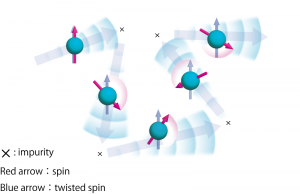It’s there if you know where to listen Spin orientation conserved through spin-orbit echo

As technological development drives the miniaturization of electronics to the nanoscale, components that were useful at larger scales cease to function effectively due to the quantum mechanical nature of electrons. Spintronics, a field that has been attracting significant attention from researchers in recent years, offers one potential solution to this problem.

©Naoyuki Sugimoto and Naoto Nagaosa<br>Changes of electron spin orientation under spin-orbit interaction with elastic impurity scattering. Twisted spin does not change.
While conventional electronics expresses the zeroes and ones of computer language by the presence or absence of electric charge, spintronics employs spin orientation (“up” or “down”), which is a quantum mechanical quantity.
However, it is not as simple to store information using spin orientation as it is using charge. Charge is a “conserved quantity” that does not spontaneously appear or disappear, but spin orientation in solids is not generally a conserved quantity. In particular, “spin-orbit interaction” connects the spin orientation and the orbital motion of electrons in a solid, and changes the spin orientation.
Professor Naoto Nagaosa of the University of Tokyo Graduate School of Engineering and Postdoctoral Researcher Naoyuki Sugimoto of the RIKEN Correlated Electron Research Group have demonstrated theoretically, and confirmed numerically, a phenomenon they term “spin-orbit echo” by which spin information is preserved even under spin-orbit interaction.
By regarding spin-orbit interaction as multiple magnetic fields, the researchers discovered that there exists a quantity that does not change, which they termed “twisted spin.” While spin itself is not a conserved quantity, spin information is conserved in twisted spin and by slowly (adiabatically) reducing spin-orbit interaction, the original spin orientation is also slowly restored.
This discovery of a conserved quantity under the influence of multiple fields is not only a major step towards the use of spintronics in next-generation devices, but is also a significant advance in our understanding of electronic state in the world of quantum field theory.
(Public Relations Division, The University of Tokyo, Azusa Minamizaki, Euan McKay.)
Department release/press release
Paper
Naoyuki Sugimoto and Nagaosa Naoto,
“Spin-orbit echo,”
Science [336] (2012): [1413-1416], Online Edition: 2012/6/15 (Japan time), doi: 10.1126/science.1217346
Article link







